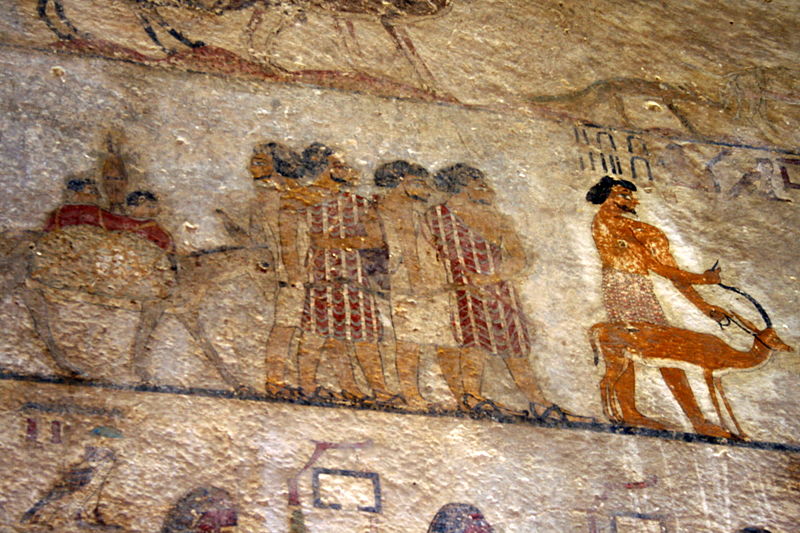
Photo by Kurohito, free license Wikimedia-France
ABRAHAM IN EGYPT
According to scholars counting back Biblical generations and using statements in the Bible about Israel's sojourn in Egypt; Abraham lived about 1800 BC.
In Genesis 12 Abraham paid a visit to Egypt and was rewarded for the sake of his beautiful woman:
"16 And he dealt well with Abram for her sake: and he had sheep, and oxen, and he-asses, and men-servants, and maid-servants, and she-asses, and camels." (ASV)
In Genesis 24 Abraham sent a servant to Mesopotamia to seek a wife for his son Isaac. The servant returned with Rebecca who had agreed to marry Isaac without having seen him. She arrived at Abraham's place and descended from her camel.
1800 BC Egypt was in the Middle Bronze Age; a time when domestic riding camels were not known to Egypt or Mesopotamia. A comprehensive study of Egyptian art reveals many different domestic and wild animals depicted in paintings, statues, and engravings. About this time oxen were used for plowing. Donkeys were used to transport people and cargo. Horses were not seen in tomb paintings until the time of Thutmosis III (c. 1450 BC). There is a small amount of evidence for domestic camels in the Ancient Near East outside of Arabia in the Late Bronze Age closer to 1200 BC, yet the evidence is minor. The evidence for domestic riding camels in Syria becomes greater about 1000 BC especially by the end of the 8th century BC. This and other evidence caused some scholars to assume the Bible was written later rather than earlier. It was written during a time when camels were more common in Israel, Egypt, and Mesopotamia.

Photo by
Kurohito,
free license Wikimedia-France
A scene from the Beni Hasan, Tomb of Khnumhotep, c. 1880 BC shows a group of Asiatics traveling in Egypt to trade kohl (cosmetics). They had donkeys as transportation. The tomb paintings showed the men and women wearing garments of brilliant colors such as were made with red and purple dyes manufactured from shellfish along the coasts of Canaan. This is evidence for Canaanites going into Egypt during the supposed time of Abraham, but not for them riding on camels as the camel was not domesticated in Egypt in 1900-1800 century BC.
In the web site linked below are color photos of this Aamu scene.
While Jesus talked about Abraham, it is likely he was only referring to elements of the story of Abraham.
Some may interpret this as Jesus telling them he was before Abraham was born, yet a more comprehensive research may reveal that Abraham was a literary figure, but never born.
Further Discussion:
In Genesis 21:32 Abraham was described as dwelling in Beersheba, in the "land of the Philistines." The Philistines (Peleset) were from Crete and/or the Mediterranean isles and recorded as attacking Egypt during the reign of Ramesses III (1186-1154). They were repulsed. The Philistines settled the coast between Gaza and what is now Tel Aviv (Tel Qasile). They were not in possession of this land during the time of the setting for the story of Abraham.
More websites: dqhall.com
David Q. Hall
dqhall59@yahoo.com